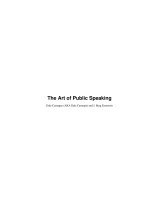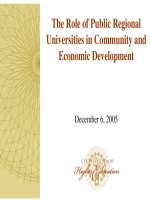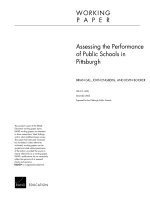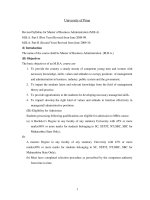Governing Electronically E-Government and the Reconfiguration of Public Administration, Policy and Power potx
Bạn đang xem bản rút gọn của tài liệu. Xem và tải ngay bản đầy đủ của tài liệu tại đây (781.94 KB, 284 trang )
Governing Electronically
9780230_205888_01_prexii.pdf 12/5/09 11:30 AM Page i
Also by Paul Henman
ADMINISTERING WELFARE REFORM: International Transformations in
Welfare Governance (co-edited with Menno Fenger)
CROSSTALK: Topics of Australian Church and Society (edited)
9780230_205888_01_prexii.pdf 12/5/09 11:30 AM Page ii
Governing Electronically
E-Government and the Reconfiguration of
Public Administration, Policy and Power
Paul Henman
9780230_205888_01_prexii.pdf 12/5/09 11:30 AM Page iii
© Paul Henman 2010
All rights reserved. No reproduction, copy or transmission of this
publication may be made without written permission.
No portion of this publication may be reproduced, copied or transmitted
save with written permission or in accordance with the provisions of the
Copyright, Designs and Patents Act 1988, or under the terms of any licence
permitting limited copying issued by the Copyright Licensing Agency,
Saffron House, 6-10 Kirby Street, London EC1N 8TS.
Any person who does any unauthorized act in relation to this publication
may be liable to criminal prosecution and civil claims for damages.
The author has asserted his right to be identified
as the author of this work in accordance with the Copyright, Designs
and Patents Act 1988.
First published 2010 by
PALGRAVE MACMILLAN
Palgrave Macmillan in the UK is an imprint of Macmillan Publishers Limited,
registered in England, company number 785998, of Houndmills, Basingstoke,
Hampshire RG21 6XS.
Palgrave Macmillan in the US is a division of St Martin’s Press LLC,
175 Fifth Avenue, New York, NY 10010.
Palgrave Macmillan is the global academic imprint of the above companies
and has companies and representatives throughout the world.
Palgrave® and Macmillan® are registered trademarks in the United States,
the United Kingdom, Europe and other countries
ISBN-13: 978-0-230-20588-8 hardback
This book is printed on paper suitable for recycling and made from fully
managed and sustained forest sources. Logging, pulping and manufacturing
processes are expected to conform to the environmental regulations of the
country of origin.
A catalogue record for this book is available from the British Library.
A catalog record for this book is available from the Library of Congress.
10987654321
19 18 17 16 15 14 13 12 11 10
Printed and bound in Great Britain by
CPI Antony Rowe, Chippenham and Eastbourne
9780230_205888_01_prexii.pdf 12/5/09 11:30 AM Page iv
For
HRW who taught me to aspire
JEH who taught me to critique
&
BCL who taught me to have passion
9780230_205888_01_prexii.pdf 12/5/09 11:30 AM Page v
This page intentionally left blank
Contents
List of Abbreviations ix
Acknowledgements xi
Part I Examining E-government 1
1 Introduction 3
The consequences of technology 5
Locating and understanding e-government 7
Structure and argument of the book 10
Undertaking the study 12
2 Conceptualising Technology and Government 17
The things things do 20
Governmentality 24
Information technology and government 28
3 The Governmentality of E-government 33
Part II Domains of E-government 45
4 E-Welfare 47
International context 47
The Australian welfare system 50
The e-welfare case studies 52
Moving forward: Future directions in e-welfare 69
5 E-Tax 73
International context 73
The Australian taxation system 78
The e-tax case studies 81
Future directions in e-tax 93
6 E-Health 95
International context 95
The Australian health system 98
The e-health case studies 100
Future directions in e-health 110
vii
9780230_205888_01_prexii.pdf 12/5/09 11:30 AM Page vii
Part III Reconfigurations of Government 113
7 Reconfiguring Public Administration 115
The changing face of public administration 116
E-public administration? 123
8 Speed, Time and the Future 133
Technology and time 133
E-government and time intensification 137
Governing the future 144
9 Networks and Conditionality 150
Networks and policy 151
The new conditionality 156
10 Risk and Targeted Government 167
Characterising risk governmentalities 169
Governing risk through e-government 174
Electronic transformations in risk governmentalities 180
Towards targeted government 187
11 Complex Government 191
Increasing policy and administrative complexity 192
A case study on policy complexity 196
Why complexity matters 199
Governing complexity? 207
12 Reconfiguring Power, Citizenship, Society 209
Foucault’s notions of power 212
E-government’s varieties of power 215
Reconfiguring citizens and subjects 222
Reconfiguring society: The fragmentation of the social 228
Conclusion: Governing electronically 238
Notes 241
References 247
Index 267
viii Contents
9780230_205888_01_prexii.pdf 12/5/09 11:30 AM Page viii
List of Abbreviations
ABN Australian Business Number
ABR Australian Business Register
ACIR Australian Childhood Immunisation Register
AFDC Aid to Families with Children
AHIC Australian Health Information Council
ANAO Australian National Audit Office
ATO Australia Taxation Office
AUSTRAC The Australia Transaction Reports and Analysis Centre
B2B Business to Business
CEO Chief Executive Officer
CIO Chief Information Officer
CTPA Centre for Tax Policy and Administration
DGI Direction General des Imports
DoFA Department of Finance and Administration
DoFD Department of Finance and Deregulation
DoHA Department of Health Ageing
DSS Department of Social Security
EDI Electronic Data Interchange
EITC Earned Income Tax Credit
ELS Electronic Lodgement Service
FaCS Family and Community Services
FAO Family Assistance Office
GDP Gross Domestic Product
GIS Geographical Information System
GPII General Practice Immunisation Incentive
GST Goods and Services Tax
HCA Human Capital Alliance
HIC Health Insurance Commission
ICT Information and Communications Technology
IRAS Inland Revenue Authority of Singapore
IRS Internal Revenue Service
IT Information Technology
JSCI Job Seekers Classification Index
KPI Key Performance Indicator
LEAD Learning Earning and Parenting
MOU Memorandum of Understanding
ix
9780230_205888_01_prexii.pdf 12/5/09 11:30 AM Page ix
NAO National Audit Office
NOIE National Office of the Information Economy
NPM New Public Management
OECD Organisation for Economic Co-operation and
Development
OED Oxford English Dictionary
OTA Office of Technology Assessment
PBS Pharmaceutical Benefits Scheme
PFI Private Finance
PKI Public Key Infrastructure
PPP Public Private Partnership
SSL Supplementary Security Income
TANF Temporary Assistance for Needy Families
WFTC Working Family Tax Credit
x List of Abbreviations
9780230_205888_01_prexii.pdf 12/5/09 11:30 AM Page x
Acknowledgements
We live in a world infused with technologies, many old and many new.
Each day we learn of new technological advances often promoted to
redefine our lives and our societies. Information and communication
technologies (ICTs) have always been a part of the human social exper-
ience from the invention of human language and writing, to the rapidly
evolving world wide web. These ICTs are central to modern life including
our personal and social relationships, our employment and our experience
of work, and the operation of the modern state. The advent of the inter-
net has generated new and heightened interest in the governmental oper-
ations of the state, spurring new debates about power, democracy, surveil-
lance and freedom.
The origins of my intellectual journey, of which is this book repre-
sents another step, began before the internet became commonplace
and euphorically celebrated. As such it contains a critical stance to much
e-government literature, which is neither theoretically nor historically
informed. By studying contemporary uses of ICTs by governments, this
book seeks to offer a more nuanced appreciation of what new and often
networked ICTs are contributing to the reconfiguration of public admin-
istration, policy and power. As such, this book does not present the use
of the internet (and other advanced ICTs) by government as a major
rupture in the practices of the state. Nor does it argue that such use is
simply a further extension of a continuous trajectory. In the same way
this book is neither an account against or for technology. A further
dualism that this book seeks to bypass is one that posits either that techno-
logy drives social change on the one hand, or social actors and dynamics
drive technological deployment and change. Rather, it argues that con-
temporary ICTs in their complex interweaving with social actors and
political endeavours, contribute subtly to the practice of government, but
nonetheless their contribution can be at times significant. Charting and
making visible these dynamics is the objective of this book. It is by
making such dynamics visible, the possibility of thinking and acting
otherwise is given birth.
As with all major projects, this one has been influenced by and con-
tributed to by a number of human and non-human actors. I particularly
want to thank the enormous intellectual and personal contribution of
Mitchell Dean and Michael Adler who have in different ways supported
xi
9780230_205888_01_prexii.pdf 12/5/09 11:30 AM Page xi
and encouraged my intellectual journey to see its fruition. Their separate
collaborations with me are evident in the pages of this book. I also thank
the many research staff and dear colleagues – Louise Healey, Sharon
Gaby, Princess Fiona, Stephen Thornton and John Owen – who have been
invaluable in bringing this project to a close through conducting research,
finding literature, drafting passages, editing and proof reading. I am also
indebted to my family who have held me together emotionally – my part-
ner Anthea who has lovingly understood the stresses involved, and my
father-in-law Rod, who sparked the initial idea of putting my dual inter-
ests of computers and social policy together – and my medical team
who and medical devices that have held me together in body. This book
is dedicated to those who helped form me: to my late grandfather Harold
Raymond William Mogridge who taught me to aspire; to my mother
Jenny Henman who introduced me to critical thought; and my father
Brian Henman who showed me how to have passion in what one does.
The non-human actors that have contributed to this achievement
include the Australian Research Council’s Discovery Grant with Mitchell
Dean (DP0209812), various internal small research grants from Macquarie
University and the University of Queensland. I finally acknowledge per-
mission from the BBC to quote from the ground-breaking Walking with
Dinosaurs television series, the Australian Commonwealth government to
reprint figures from the Parliamentary Joint Committee of Public Accounts
and Audit Report, and Maringka Baker, Amanda Dent and Nick Nicholson
to reproduce Ms Baker’s stunning artwork Kuru Ala on the book’s cover.
xii Acknowledgements
9780230_205888_01_prexii.pdf 12/5/09 11:30 AM Page xii
Part I
Examining E-government
9780230_205888_02_cha01.pdf 10/19/09 4:02 PM Page 1
This page intentionally left blank
1
Introduction
It is undeniable, we are governed by technology today. E-government,
or the use of electronic information and communications technology
(ICT) for the conduct of government (also referred to as digital gov-
ernment and electronic government), involves both a disrupture
and a continuation of the nature of government in modern nation
states. The emergence of the internet, in particular, has stimulated
a new interest among politicians, public administrators and academics
about the role of technology in government. Much has already been
written and debated, with considerable attention being given to
the meaning of e-government for contemporary public administration
and management, political participation and democratic processes.
The unique contribution of this book is its focus on the role of
e-government in public and social policy processes. In short, the
key message of this book is that e-government has underpinned
an evolving process in the reconfiguration of the very nature of
public and social policy, with implications for public administra-
tion, political power and citizenship. To illustrate this point, I begin
with an analogous story about information technology and scientific
discovery.
In 1999, the BBC aired its ground breaking ‘nature documentary’
Walking With Dinosaurs. In the last episode which explained the
making of that TV series, a discussion about the role of computer
modelling technology grabbed my attention. The developers explained
that while computer modelling was necessary to make the film, it
led to some unexpected scientific insights and surprises. The computer
animated models were based on the bone structure of dinosaurs known
from fossils. However, archaeologists must make educated guesses
3
9780230_205888_02_cha01.pdf 10/19/09 4:02 PM Page 3
about a dinosaur’s activity, including their gait, based on the animal’s
fossil, as the following excerpt from Walking with Dinosaurs explains.
Animator: ‘Well the first thing that happened was that the palaeon-
tologists arrived en masse and told us what they knew about
dinosaur movement, and the length of dinosaur bones, about the
limits of motion of the skeletal structure. They can tell us, “this
dinosaur did not move its neck higher than 20 degrees”. They can
tell us, “this animal did not run, because if it did it would fall over
and break all of its legs.” But when it finally comes down to it, it’s
up to the animators, because there’s an awful lot they can’t tell us.’
1
The film-makers explained that when they made a computer model
of the bone structures and considered possible movements of these
structures, they were able to see for the first time how the dinosaurs
actually moved. This process is captured in the following dialogue
between the series narrator and the two of the advising scientists:
Narrator: ‘And so all this expertise was slowly put into practice
as the characters were animated, limb by limb. … One by one, the
statues were coming to life. In the process, even the palaeontologists
were learning a thing or two.’
Palaeontologist 2: ‘Working with the animators and the designers, I
was able to see my skeletal reconstructions changed into something
more like a dynamic animal, moving. By doing that, I had to think
very seriously about the dynamics of the joints, where the way the
bones moved in relation to one another. That’s the critical differ-
ence that these animation programs provide for us, and that brings
the animals to life more than I had appreciated, first of all.’
The computer technology gave rise to scientific insight and discovery.
Palaeontologist 3: ‘The film-makers, in making computer models
and physical models, have actually been teaching the palaeonto-
logists some things. They’ve been showing us what works and what
doesn’t work. And, I’ve been delighted to see that the information
has actually been flowing in both directions.’
This account of the animation of dinosaurs using computer models
demonstrates that it is too simplistic to describe the technology as merely
a tool operating in accordance to human needs and visions. It is certainly
4 Governing Electronically
9780230_205888_02_cha01.pdf 10/19/09 4:02 PM Page 4
true that people make decisions about using and building the tech-
nology, but the very operation of that technology independently can
generate unintended outcomes. It is widely acknowledged that the
deployment and use of technologies can often involve unintended
consequences. For instance, technologies may break down or not
operate in the manner intended and the creativity of humans may
mean that technologies are deployed by end users in ways not
originally envisaged by their designers. However, I am suggesting
something more significant: that technologies can give rise to new
knowledge and conceptual and intellectual advances, such as new
insights about the movement of long-extinct dinosaurs described
above. In this regard, technologies are creative, the result of a process.
Their action is innovative.
Transferring this insight from dinosaur animation to e-government,
this book’s key argument is that the use of advanced electronic in-
formation technologies can also create new ways of understanding,
being and acting both within and beyond government. Deploying
e-government can and does generate new insights into the way in
which we think about and design public and social policy, how gov-
ernment policy and services are implemented and managed, the rela-
tionship between citizens and the state, and more fundamentally
about the nature of contemporary government itself, including its
rationale and objectives.
2
In continuing to introduce this project, the remainder of this chapter
locates the study within broader observations about the unintended
consequences of technology and previous insights about the use of
technology in government.
The consequences of technology
One of the most hotly debated topics in the social study of technology
literature is the causal relation between technology and society. In its
most simplistic formulation, it is a question of whether technology
causes (or, in the softer version, shapes) social dynamics, or whether
social processes causes (or shapes) the nature of technology and the
uses to which it is put.
3
If it were only so simple. Casting the question
as an either/or question is part of the original problem. Rather, social
analysts need to be alert to both the relays from society to technology
and vice versa. Furthermore, within social studies of technology authors
have repeatedly argued that we need to question the very dichotomy
between society and technology and instead examine and analyse the
Introduction 5
9780230_205888_02_cha01.pdf 10/19/09 4:02 PM Page 5
‘seamless web’ of ‘socio-technical systems’ (Bijker et al 1987). Indeed,
it is highly problematic to make a distinction between technology
and society, as what is technological is also social, and what is social
is also technical (Callon 1987; Callon and Latour 1992; Hughes 1986;
Law 1992). Despite these lessons, accounts of social change under-
pinned by a version of technological determinism still seem to
arise again, again and again, as do accounts underpinned by social
determinism.
There are two other conceptual predispositions attached to the deter-
minism debate. The first is agency. Deeply embedded within socio-
political thinking is the idea that only humans have agency, that it is
only humans who have consciousness to determine their behaviours.
4
Under such a definition, technological artefacts – such as today’s elec-
tronic information and communication technologies
5
– are not regarded
as having agency. However, such a dualism of humans who have agency
to initiate action and artefacts who do not, conceptually exorcises any
role of artefacts in social change. Rather, it is necessary to appreciate the
activity of artefacts that is independent of human agents. In this respect,
Bruno Latour and Michel Callon (Callon 1986a; 1986b; Latour 1988;
1991) have provocatively argued that non-humans are ‘actors’ (see also
Ashmore et al 1994). This nomenclature is not to argue that non-humans
have consciousness or intention, but that their activity needs to be under-
stood in some sense as independent from human intention. This
chapter’s opening story of dinosaur computer modelling illustrates this
point. Whether or not we decide to ascribe ‘agency’ to non-humans, we
must accept the reality that technology produces outcomes which are
significant and have an effect in a host of other arenas.
The second conceptual predisposition attached to the determ-
inism debate is the apolitical nature of technological artefacts, a pre-
disposition that flows partly from the first. It is often held that artefacts
have no politics. They are morally and politically neutral tools. The
classical argument for this view is that an artefact can be used for good
or ill. Consequently, it is the act of a human user, so this argument
goes, that draws the artefact into the user’s political and moral acti-
vities. Such a position is tenable if we were to overlook the activity of
artefacts. However, if we are to take the view that artefacts do some-
thing independently of humans, as argued above, then we must seek
to understand what that activity might contribute to contested human
affairs. In particular, we need to seek to understand the forms of know-
ledge and ways of operating which are embedded within and mobilised
by technology. What ways of knowing might a particular artefact
6 Governing Electronically
9780230_205888_02_cha01.pdf 10/19/09 4:02 PM Page 6
embody? What forms of human behaviour might they reinforce? To
make the case more digestible, a social constructivist of technology might
identify the ways in which human actors construct an artefact in such a
way to embody and mobilise a particular type of politics and forms of
social relations. In this way, the artefact’s political activity is a surrogate
for human political activity. Such a view is evident in Latour’s notion of
technology enabling ‘action at a distance’ (1988b; 1991).
The foregoing ruminations point towards the perspective on tech-
nology in general, and e-government in particular, taken in this book.
In short, the approach taken in this book, which is further elaborated
in Chapters 2 and 3, is that technological artefacts are intimately
enmeshed in human activity to such an extent that it is quite difficult
to attribute causation to a specific component. Rather, transformations
in social and, more specifically, government processes must be under-
stood as an outcome of the dynamic and close interweaving of humans
and non-humans, discourses and materialities.
6
Given this perspective, it is a fair question to ask why this book tends
to focus on the technological side of e-government and what it contri-
butes to the social side of government, in terms of public administra-
tion, policy and power. The reason this book gives primacy to material
technology (or non-humans) is because technological artefacts, and
particularly their productive power, has been overlooked. The book’s
message to social scientists who focus on humans is that technological
artefacts act; and what they do is important to the social domain. But
the book also has a message to those scholars who focus on artefacts:
that the contribution of technologies to the social domain must be
understood as arising from the complex interweaving of humans and
non-humans, and not as inanimate objects to be located within a social
context. Returning to the Walking with Dinosaurs anecdote, we need to
appreciate what the computer models do – namely give rise to new
insights about the gait of long-extinct animals – but we can not divorce
that contribution from the activity of scientists and movie-makers, their
prior knowledge, their quest for further knowledge and their activity in
building technologies to assist those intellectual dreams.
Locating and understanding e-government
E-government is now a topic of considerable academic, business
and government interest. Several academic journals are now devoted
to its inter-disciplinary study, and involve scholars as diverse as
information technology and information science, management and
Introduction 7
9780230_205888_02_cha01.pdf 10/19/09 4:02 PM Page 7
organisational studies, and political scientists. Perri 6’s four-way
characterisation of e-government as involving e-democracy, e-service
provision, e-management and e-governance helpfully indicates the
breadth of activities involved in e-government (2004: 15–17).
For 6, e-democracy involves the use of digital networks by which gov-
ernment solicits or receives the views of citizens, businesses and other
organisations ‘on matters ranging from full-scale legislative change to
the tweaking of the management of services and programmes’ (2004:
15). E-service provision refers to the use of electronic technologies for
the delivery of public services. E-management designates those activities
which use digital technologies to allocate resources within government
under the terms of existing government policy, whereas e-governance
involves ‘digital support for policy formulation and the scrutiny and
oversight of the achievement of policy goals’ (2004: 16).
This is indeed a huge range of government activities. This book
gives attention to the last three domains of e-government as defined
above, and ignores the contribution of digital technologies to demo-
cratic processes. The reason for this emphasis is two-fold. Firstly,
e-democracy is an expansive academic field in itself and a critical
engagement in it involves a detailed consideration of democratic
theory, which is beyond the scope of the current project. Secondly,
the focus of this book on the productive capacity of technology to give
rise to new ways of thinking about the nature and practice of govern-
ment involves a key focus on policy. Indeed, 6’s characterisation of
e-government is unusual in recognising the contribution of digital
technologies to policy formulation, a domain largely unexamined in
e-government research. In analysing the contribution of technology to
policy making processes, 6’s (2004), my previous work (Henman 1997;
1999; 2006) and this book are arguably unique, and consequently
offer readers a rare vantage point to appreciate our contemporary,
technologically-infused government.
Given the largely unexamined contribution of technologies to policy
making, it is worth considering why this might be so. A key reason for
treating machines as ‘monsters’ to be overlooked (Law 1991) reflects
the traditional conceptualisation of policy processes, whereby policy
making and policy administration are understood as two distinct activ-
ities. Policy making occurs first and dictates the activities of policy
administration. Administration is the handmaiden to policy making.
There are important political reasons for this demarcation, such as
ensuring policy is democratically accountable through the elected
government. Administrative technologies – of which information
8 Governing Electronically
9780230_205888_02_cha01.pdf 10/19/09 4:02 PM Page 8
technologies are arguably the most important – are characterised as
part of policy administrative processes, rather than policy making
processes. They are regarded as neutral tools to implement policy. This
simplified conception of policy making has a strong hold on the acad-
emic and popular imagination. However, the fissure between policy
administration and policy making is far fuzzier in practice (Hudson
and Lowe 2004: ch. 12; Verschuere 2009). Indeed, the tradition of
street-level research has consistently made this point (Lipsky 1980;
Brodkin 2003). This book provides another challenge to rethink the
classical demarcation between policy making and policy administra-
tion, and thereby allows a space to rethink the role of technology in
government policy processes.
In addition to challenging widespread assumptions about public
policy and the role of technology in those processes, this work also
challenges implicit assumptions that e-government is ‘new’. As
Chapter 3 discusses in greater detail, the term ‘e-government’ arose in
the late 1990s as part of the popularisation of the internet and the
World Wide Web. This technological event stimulated intense acad-
emic and political interest in the use of ICTs for the conduct of gov-
ernment. Yet this interest largely failed to appreciate that computerised
information technologies have been operating in government for
decades and that the new internet technologies were in fact being built
on top of and reliant upon those technologies. As a result, lessons from
studying these previous uses of ICTs by government were not utilised
in the rush to examine the apparent newness and uniqueness of the
internet. Examples of prior studies of information technology in gov-
ernment includes a study group of the European Association of Public
Administration which has been studying ICTs in public administration
since the late 1980s (Taylor 2007). In the USA, Rob Kling and Kenneth
L. Kraemer conducted seminal work on ICTs in USA governments from
the late 1970s (Kling 1978a; 1978b; Kraemer and Kling 1985; Kraemer
and King 1986; Iacono et al 2003).
Not only has the academic rush to join the e-government bandwagon
largely failed to incorporate the lessons from earlier studies of ICTs
in government, but it has on the whole been uninformed by theoretical
and empirical insights from social studies of science and technology.
This book seeks to address these shortcomings in current e-government
literature by undertaking historically and social theoretically informed
empirical research on contemporary technologies in government.
In keeping with the focus of this book on the use of electronic
information and communication technologies in government, the
Introduction 9
9780230_205888_02_cha01.pdf 10/19/09 4:02 PM Page 9
specific empirical question I seek to address is what such technologies have
contributed to the practice of government. To that end, I am not making
grand claims about the wholesale restructuring of society on the basis of
computers, nor am I positing a particular mode of government resulting
from computers. In doing so, I wish to avoid the macro statements of
writers such as Jacques Ellul (1964), Herbert Marcuse (1964), Neil Postman
(1993) and the later Martin Heidegger (1977) who saw the emergence of a
technocratic way of life. Rather, I seek to identify the particular and con-
tingent ways in which the use of ICTs in practices of governing can
emphasise, extend and give rise to contingent, yet wider transformations
in the ways contemporary government is thought and practiced.
Structure and argument of the book
The remainder of this book is organised into three parts. Part I develops
the conceptual, methodological and analytical approach to e-govern-
ment. In particular, Chapter 2 presents a conceptual approach to tech-
nology and government such that technology can be understood as
exhibiting governmental capabilities. The conceptualisation of techno-
logy largely draws on Heidegger’s later work, while the idea of govern-
ment, as the ‘conduct of conduct’, draws from the writings of Michel
Foucault. In particular, the practice of government is understood as involv-
ing both ‘political rationalities’ and ‘technologies of government’. This
conceptualisation of government underpins a central thesis of this book,
namely that not only do political rationalities shape the ways in which
e-government is configured and used, but also the use of e-government
can shape the formation and configuration of political rationalities.
Chapter 3 builds on this conceptual approach to examine the very
idea of ‘e-government’. It examines ‘e-government’ as a governmental
rationality in order to destabilise its naturalness and highlight the
assumptions built into the terminology. The political ambitions for
reconfiguring public administration that are embedded in e-government
discourses is made visible, but so is the way the discourses involve a
historical forgetting of previous governmental uses of ICTs.
Part II presents six e-government case studies from three key policy
domains, namely welfare (Chapter 4), taxation (Chapter 5) and health
(Chapter 6). Readers not interested in the details of the e-government
case studies can bypass these and read Part III for the lessons from their
analysis. These studies provide empirical data with which to begin the
analysis of e-government’s contribution to reconfiguring public admin-
istration, policy and power (Part III). These are Australian case studies,
10 Governing Electronically
9780230_205888_02_cha01.pdf 10/19/09 4:02 PM Page 10
but are very much located in the international context and are under-
stood as indicative of broader transformations in e-government and
government. How these case studies were undertaken is outlined in the
next section of this introductory chapter.
The major conceptual contribution to the study of contemporary tech-
nological government is contained in Part III. Drawing from the empirical
case studies and wider research, Part III analyses the contribution of e-
government to reconfiguring public administration, policy and power. In
doing so, this section makes visible the ways in which information tech-
nologies operate as a productive form of power, giving rise to new ways
of thinking about and enacting government. Consistent with the con
ceptual approach in earlier chapters, the analysis and claims made in
Part III recognise the socio-political milieu in which technology operates.
Chapter 7 begins the analysis by examining e-government’s contribution
to transformations in public administration, where shifts towards and
technological tensions with New Public Management is discussed. The role
of ICTs in undertaking and reconfiguring policy making processes is also
discussed. With a focus on both public administration and policy making
processes, Chapter 8 examines e-government’s role in the constitution and
governance of time, particularly the experience of time intensification.
With Chapter 9, the focus turns more heavily on e-government’s
contribution to the reconfiguration of the actual structure and sub-
stance of public and social policy and associated political rationalities.
In particular, Chapter 9 examines how networked ICTs are contributing
to a growth in a new form of conditionality in social and public policy,
whereby government benefits and services in one policy domain are
made conditional on citizen behaviour and associated data in another
policy domain. Chapter 10 examines the government of ‘risk’ and the
contribution of e-government in managing risk in two particular ways.
Technology is used as a system-wide response to govern systemic risk,
and e-government is leading to a growth in the conceptualisation and
conduct of targeted forms of risk government, whereby populations
are differentiated and governed differentially. Chapter 11 extends the
lessons of earlier chapters by examining the way e-government is enhanc-
ing complex government by both enabling policy and administration
to be increasing complex and simultaneously helping citizens and admin-
istrators to manage that complexity. Chapter 12, the final chapter, draws
the lessons from the earlier Chapters of Part III together to examine the
power effects of e-government and what this means to the reconfigur-
ation of citizenship, subjectivity and society. This chapter then draws the
threads together in a brief conclusion.
Introduction 11
9780230_205888_02_cha01.pdf 10/19/09 4:02 PM Page 11
Undertaking the study
E-government is a field of great and frequent change with continual inno-
vation and development. The governmental application of advanced elec-
tronic information and communication technology is extremely varied in
terms of the policy and institutional domain, the nature of governmental
activity (for example, the administration and management of policy, the
delivery of services, the development, analysis and evaluation of policy,
the involvement of political and democratic processes and interacting
with and reporting by external organisations to government), the objec-
tives to which e-government is seeking to deliver and the specific tools
which are constructed and deployed. Because of this great flux and diver-
sity it is all too easy to approach the examination of e-government by
identifying and focusing on new and innovative technologies. Attention
and excitement typically gravitates to the new tools.
However, if the task is to try to understand the contribution of
e-government to the reconfiguration of public administration, policy
and power, as this book seeks to do, it is not necessarily the new tools
which hold the most original observations. This is partly because new
tools may be used in more marginal aspects of governmental oper-
ations, or they may simply replicate prior ways of operating. At times,
it is the more mature technologies, which have evolved in terms of
their use and their integration and transformation of organisational
practices, that provide deeper insights about the way in which techno-
logies are incorporated into and contribute to social transformations.
This is not to deny that the deployment of new technologies often can
starkly highlight the disjuncture between former and newer forms of
operating, and also reveal new insights about the former approach. Yet
the deployment of older technologies in new ways can do the same. In
short, it is not so much innovative technologies that generate new
insights, but innovative uses of technologies, in this case, for under-
taking public administration and policy processes. For these reasons
the six e-government case studies were carefully selected to illuminate
the involvement and implications of e-government for public policy
making and service delivery. The lessons from these case studies form
Part III of this book.
Some of the e-government case studies represent recent innovations
(for example, online interactive portals), whereas some are more mun-
dane and longer standing (for example, databases). Some have been
immensely successful, while others failures. Some have been accorded
high public visibility, whereas others have been quietly operating in
12 Governing Electronically
9780230_205888_02_cha01.pdf 10/19/09 4:02 PM Page 12









